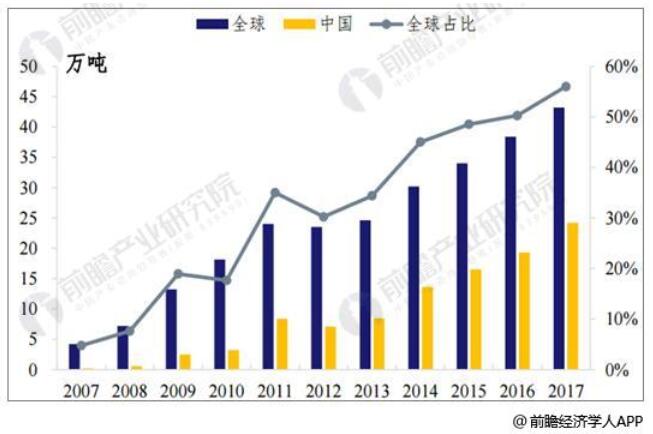The market demand for polysilicon industry continues to expand
Demand for polysilicon continues to expand
As a basic industry that relies on the growth of new industries such as new materials (organic silicon, etc.), semiconductors (electronic-grade polysilicon), and photovoltaic (solar-grade polysilicon), the silicon industry has achieved rapid development in China in recent years. Especially with the continuous expansion of the demand for solar grade polysilicon in the photovoltaic industry, the correlation between the cyclical fluctuations of the silicon industry and the photovoltaic industry is becoming more and more close.
Comparative analysis of global and China's polysilicon production
According to the statistics of the “In-depth Research and Investment Strategy Planning Analysis Report of the Polysilicon Industry†released by the Prospective Industry Research Institute, the price decline was driven by technological progress before 2012. Compared with the price of silicon materials in 2011, the price of silicon materials dropped by 40%. Relationship decision. The expansion of the photovoltaic market led to an increase in demand for silicon materials. In 2017, global production was 10 times that of 2007. In 2017, global polysilicon production was about 432,000 tons, up 13.7% year-on-year; of which, China accounted for 56% for the second consecutive year. The proportion is more than half, ranking first in the world; South Korea's output is 77,000 tons, up 4.1% year-on-year, ranking second; Germany's output is 58,000 tons, down 7.9% year-on-year, ranking third.
Global Global and China Polysilicon Production in 2007-2017

Source of data: public information, prospective industry research institute
2017 China's polysilicon production ranked first in the world

Source: Prospective Industry Research Institute
China's polysilicon import ratio is still large, surviving alternative space
The main downstream silicon wafers of polysilicon occupy more than 90% of the global market. Therefore, compared with the total demand of polysilicon materials in China, the import dependence is still high. In 2017, China's polysilicon imports were about 159,000 tons, and its import dependence was close to 40%. With the continuous expansion of domestic polysilicon production capacity, the import ratio of polysilicon is expected to decline gradually.
The expansion of domestic demand for downstream polysilicon will effectively boost the growth of industrial silicon demand in China. In addition, although the absolute amount of polysilicon used in the semiconductor industry is small, the annual demand is about 30,000 tons, but benefiting from the rapid expansion of the downstream market and the acceleration of the localization process, it is expected that electronic grade polysilicon will bring new increments to the demand of industrial silicon in China. space.
China's China's polysilicon import and import dependence statistics for 2009-2017

Source of data: public information, prospective industry research institute
Capacity Analysis and Forecast of the Top 5 Silicon Materials Enterprises in the World
In 2018, it is estimated that the newly added capacity will be 12-13 million tons. Among the top 5 polysilicon manufacturers in the world, China's enterprises will occupy 3 seats, and GCL-Poly will lead with 96,000 tons/year. In domestic enterprises, 10,000 tons will be added in 2018. There are 5 enterprises, Sichuan Yongxiang expands 50,000 tons, Xinjiang Xiexin expands 20,000 tons, Shanxi Ruike expands 19,000 tons, Dongfang hopes to expand 15,000 tons, and Jiangxi Saiwei expands 10,000 tons.
2016-2018 Global Top 5 Silicon Materials Enterprise Capacity Statistics Forecast

Source of data: public information, prospective industry research institute
China's polysilicon spot price fluctuations fluctuate
Affected by multiple factors such as technological progress, industrial silicon price cuts, and temporary changes in the supply and demand pattern triggered by the “531 New Dealâ€, in the first eight months of 2018, domestic polysilicon spot prices fluctuated, with an average price of 117,400 yuan/ton, down 8.1% year-on-year. After the "531 New Deal", the price dropped rapidly from 126,000 yuan/ton at the end of May to 87,800 yuan/ton in mid-July, a drop of 30.3%. After that, the price rebounded slightly. By the end of August 2018, the price rebounded 3.5% to 90,900 yuan/ton.
Product efficiency, application diversification
In fact, the synergy of polysilicon downstream products, from a certain point of view, is also a means of cost reduction. In the photovoltaic direction, for example, in the ingot section, GCL-Poly claims that based on the upgrade of the existing ingot furnace, optimizing the thermal field design can increase the efficiency of the polycrystalline cell by 0.08%-0.10%.
In the cutting of silicon wafers, diamond wire cutting is also promoted in the field of polysilicon wafer cutting, and the downstream black silicon technology can perfectly match diamond wire cutting. According to GCL-Poly, the capacity of “TS+†second-generation black silicon wafer equipment has doubled, and the cost of texturing has been reduced by about 30%. The high conversion efficiency of black silicon is obtained at a cost close to the traditional texturing, and the battery efficiency gain will be increased to 0.5. %.
Last year, the global demand for large-scale integrated circuit silicon wafers (equivalent to 8 inches) was 11.6 million pieces per month. In the future, the global demand for 12-inch silicon wafers is growing. Last year, it was 5.1 million pieces per month. It reached 5.6 million pieces/month and is expected to reach 6.4 million pieces/month by 2020. These needs will also support the production of high-purity electronic grade polysilicon.
Non Woven Bag,Custom Nonwoven Bag,Spunbond Nonwoven Bag,Custom Nonwoven Vest Bag
Chongqing Yilun Sanzi new packaging Co., Ltd , https://www.yilunmask.com